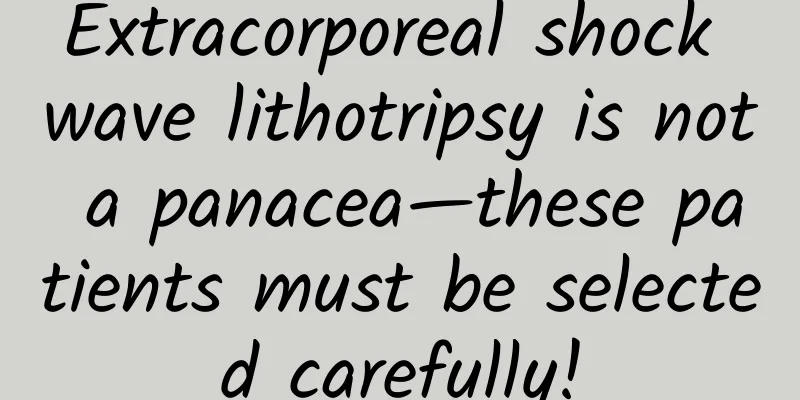Extracorporeal shock wave lithotripsy is not a panacea—these patients must be selected carefully!

|
Author: Mao Yuanshen, attending physician of the Urology Department of Sichuan Provincial People's Hospital Reviewer: Xiong Wei, Chief Physician of Urology Department, Sichuan Provincial People's Hospital Urinary stones are the most common disease in urology. Because the kidneys and ureters are located deep in the human body, the earliest generation of stone surgery often adopted the traditional incision method, which required an incision of about ten centimeters in length in the waist or lower abdomen to cut open the kidney or ureter to remove the stone. This was very traumatic and required more than a month of recuperation after the operation, so this surgical method has been almost eliminated. After the 1980s, with the rise of extracorporeal shock wave lithotripsy, the treatment of urinary stones has been revolutionized. Extracorporeal shock wave lithotripsy uses special equipment to generate shock waves, locates stones through X-rays or ultrasound, and crushes stones from outside the body, which are then excreted with urine. The birth of this treatment method has saved many stone patients from the pain of surgery and brought about a new change in the treatment of urinary stones. This treatment method, which does not require hospitalization and can "break stones from a distance", is a major innovation from surgery to minimally invasive surgery, and is accepted and welcomed by stone patients. Figure 1 Copyright image, no permission to reprint But many people don’t know that extracorporeal shock wave lithotripsy is not suitable for all patients with urinary stones. In the urology clinic, the following situation is often encountered: patients with urinary stones want extracorporeal shock wave lithotripsy as the first choice for treatment, but the doctor denies it. Why is this? Because in some cases, extracorporeal shock wave lithotripsy is not only ineffective, but may even be counterproductive. Let’s introduce which patients with urinary stones are not suitable for this treatment method. 1. Patients with stones that are too hard Due to various factors, the composition of urinary stones varies. Some patients have loose stones, so these patients can try extracorporeal shock wave lithotripsy. However, for harder stones, the energy of extracorporeal shock waves is difficult to break up. If the energy of extracorporeal shock waves is compared to a human fist, a fist can easily break an egg, but it is difficult to break a stone. Therefore, extracorporeal shock wave lithotripsy is not suitable for patients with very hard stones. 2. Patients with special stone locations When kidney stones are located in the lower calyx of the kidney, in layman's terms, the stones are located in the lower part of the kidney, just like a stone at the bottom of a bottle. Only by changing the position of the bottle can the stone be broken and poured out. Therefore, for patients with lower calyx stones, even if the stones are broken by shock waves, they cannot be easily discharged. For this type of patients, it is often recommended to use flexible ureteroscopes for endoscopic treatment. In theory, the flexible ureteroscope can enter the various "rooms" of the kidney, and through the cooperation of the stone-removing basket, it can successfully capture the fragments in various positions, which greatly makes up for the limitations of extracorporeal shock wave lithotripsy in the treatment of renal calyx stones. 3. Patients with small ureteral lumen Extracorporeal shock wave lithotripsy only breaks stones into small pieces, not powder. Clinically, some patients may have small ureteral lumens, which makes it difficult to expel stones even after they are broken by extracorporeal shock waves. Ureteroscopy is also recommended for this type of patients. Through ureteroscopy, doctors can visually see the thickness of the patient's ureter. Once the patient's ureteral lumen is found to be too thin, the ureter can be passively dilated by leaving a ureteral stent for 2 to 4 weeks, and the stones can be treated in the second stage of surgery, thereby effectively improving the success rate of the operation and the stone clearance rate after surgery. 4. Patients with stones blocking the ureter for a long time Because ureteral stones block the ureter, they will rub against the ureteral wall, causing hematuria, infection, and pain. Over time, the stones will firmly adhere to the ureteral wall, which is clinically called impacted stones. Such patients often suffer from ureteral stenosis due to long-term blockage of the ureter by stones. For such patients, if only extracorporeal shock wave lithotripsy is used for treatment, it is easy to cause stone accumulation and blockage of the ureter, making it difficult to expel the stones. In this case, it is recommended to give priority to minimally invasive treatment under ureteroscopy, which can not only treat the patient's stones, but also treat ureteral stenosis, killing two birds with one stone. 5. Patients who are too obese For obese patients, the distance from the skin to the kidneys is farther than that of people with normal body size, which not only affects the precise positioning of extracorporeal shock wave lithotripsy, but also the shock wave energy will be greatly attenuated even when it reaches the stone, directly affecting the lithotripsy effect. Ureteroscopic treatment can easily solve this problem. As an operation through the natural cavity, ureteroscopic treatment is similar to gastrointestinal endoscopy and is not affected by the patient's body shape. Clinical practice has found that the difficulty of ureteroscopic lithotripsy for patients weighing more than 100 kg is almost the same as that for patients of normal body shape. Figure 2 Copyright image, no permission to reprint 6. Patients with renal insufficiency or urinary tract infection Urinary stones often block the ureters, causing hydronephrosis and further kidney damage. When renal function is impaired, the already damaged kidneys may be more seriously damaged under the action of extracorporeal shock waves. For patients with urinary stones and infections, whether extracorporeal shock wave lithotripsy or laser lithotripsy is used, changes in renal pressure will cause bacteria in the urine to enter the blood, causing high fever, bacteremia, and even life-threatening in severe cases. Therefore, for patients with stones who have renal insufficiency or urinary tract infection, we usually choose to prioritize the insertion of ureteral stents or percutaneous nephrostomy to improve renal function and control infection, and treat the stones during the second stage of surgery. 7. Patients with lower ureteral stones For patients with lower ureteral stones, extracorporeal shock wave lithotripsy is prone to cause unnecessary damage to surrounding tissues and organs. Especially for young male patients, this treatment method may affect their semen quality and fertility. The success rate of ureteroscopic laser lithotripsy for lower ureteral stones is generally close to 100%, which is recognized as the best treatment method. 8. Patients with other factors Patients with urinary stones who have abnormal coagulation function, severe cardiopulmonary disease, diabetes, pregnancy, etc. are not suitable for extracorporeal shock wave lithotripsy. The most common tissue biological effect of shock waves is bleeding. Patients with abnormal coagulation function, such as thrombocytopenia and hemophilia, are prone to rupture of small blood vessels in the kidneys, resulting in perinephric hematoma; patients with severe cardiopulmonary disease are prone to severe arrhythmias during extracorporeal shock wave lithotripsy; patients with a long course of diabetes are also susceptible to infection, and often have diabetic nephropathy. Because the kidney tissue is fragile and the blood vessels are hardened, it is easy to induce bleeding. It is worth noting that extracorporeal shock wave lithotripsy must not be performed on pregnant patients. Therefore, in clinical practice, if you encounter a patient with pregnancy and renal colic, in addition to using painkillers as appropriate, you can first insert a ureteral stent to effectively relieve pain, and then consider surgical treatment after delivery. Figure 3 Copyright image, no permission to reprint In order to continuously improve the treatment effect of urinary stones, soft and hard ureteral treatment accompanied by laser technology through the natural cavity has come into being. Ureteral laser lithotripsy has gradually replaced extracorporeal shock wave lithotripsy due to its fast recovery and almost non-invasive characteristics, and has become the most mainstream stone treatment method. |
<<: Bipolar Disorder: A Complex Dance of Emotions
>>: Why do we tilt our head to see things?
Recommend
Can I have sex right after my period?
We know that sexual intercourse is strictly prohi...
Abdominal cramps after abortion
Women must think carefully before choosing an abo...
Where to inject anesthetic for cervical conization
The cervix is an important part of the female b...
96% of the people who took the physical examination were detected with long-term COVID-19 antibodies? Should I also take the test?
Recently, many places across the country have off...
Is it good to drink more water during menstruation?
Menstruation is something that every mature woman...
What are the weight loss drinks for women?
Every female friend is thinking about losing weig...
Can girls run during menstruation?
In our lives, many people like running as an aero...
What is the reason for a small amount of blood in the discharge?
Some women's vaginal secretions will contain ...
How many days does it usually take to detect pregnancy?
For parents who want to have children, whether th...
Is it good to drink brown sugar ginger water every day?
Brown sugar has the effect of promoting blood cir...
[Medical Q&A] How to deal with hair loss during chemotherapy?
Planner: Chinese Medical Association Reviewer: Wa...
Do you feel like there is a lump of fat down there after giving birth?
Pregnancy and childbirth are processes that every...
What to do if pregnant women have itching and pain below
Many women are very worried about their physical ...
How long after taking the ovulation injection should I have sex?
How long should you wait to have sex after the ov...









